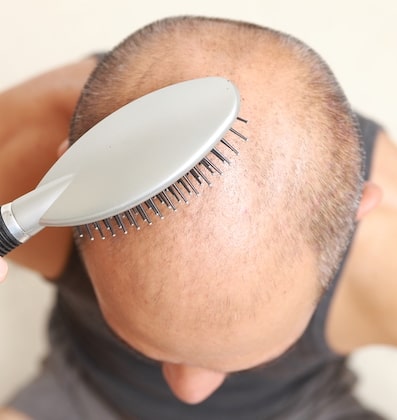Hair Restoration – What Patients Should Know
As a person ages, there is a chance that their hairline will start to recede and this condition impacts millions of people each year in the United States. The condition known as androgenetic alopecia is also referred to as male-patterned baldness and female-patterned baldness. Let’s take a look at how balding starts to appear on patients and some of the most popular and effective hair loss treatment options currently performed by hair restoration specialists across the country.
Hair Loss – Is it the Same for All Genders?
When men start to experience changes to the hairline from androgenetic alopecia, the loss of hair usually begins at the front of the scalp and the hairline will continue to recede.
On the other hand, women who experience androgenetic alopecia tend to exhibit a more diffuse and general amount of hair loss on the scalp. This means their loss of hair is seen as a decrease in the volume of hair density throughout the entire scalp.
Hair Restoration – Natural Hair Loss Treatment Options
 Some patients inquire about so-called natural remedies that have been advertised as being able to reduce the loss of hair. A partial list of natural remedies patients ask about includes peppermint oil that contains menthol as this has been said to increase the circulation of blood to the scalp, biotin supplements that some claim restore and regrow the hairline by using biotin to convert food into energy, and a scalp massage to increase the flow of blood to the scalp for increased hair regrowth.
Some patients inquire about so-called natural remedies that have been advertised as being able to reduce the loss of hair. A partial list of natural remedies patients ask about includes peppermint oil that contains menthol as this has been said to increase the circulation of blood to the scalp, biotin supplements that some claim restore and regrow the hairline by using biotin to convert food into energy, and a scalp massage to increase the flow of blood to the scalp for increased hair regrowth.
As great as all of these ideas sound, there is little in the way of hard evidence to suggest these options provide the desired results.
Hair Restoration – Over-the-Counter Medications
While minoxidil was originally used as a drug to treat hypertension, it is most popular these days as a medication that can be applied to the scalp as a foam or taken as a pill on a daily basis. The total amount of hair regrowth varies per patient, but it is not a permanent hair loss cure. Minoxidil, which is commonly referred to by the brand name Rogaine, can slow down the rate and amount of hair loss but it only works as long as the patient is committed to taking it on an ongoing basis. Once the person stops using the medication on a regular basis, the hair will eventually gain its pre-minoxidil look.
Finasteride, which is also known by the brand name Propecia, is a medication that comes in the form of an oral tablet. It is known for stopping androgenetic alopecia by increasing the testosterone of the patient. It is mostly recommended for use by male patients as finasteride has been shown to cause birth defects in women who are exposed to it while they are pregnant. Like minoxidil, the results of finasteride are not permanent, and they will start to fade away once the use of the medication is discontinued by the patient.
Hair Restoration – Hair Transplant Surgery
If a patient is looking for a surgical method of treating hair loss, they can often turn to a hair transplant to restore and improve the appearance of their hairline. Hair transplant surgery uses hair grafts from the body of the actual patient to promote the growth of hair in the thinning and balding areas of the scalp.
The hair grafts are normally taken from the donor area of the scalp which is considered to be the back and sides of the scalp. The hair in this area of the scalp has proven to be resistant to balding and it acts like the native hair on the scalp when it is transplanted by the surgeon to the treated area.
The amount of hair grafts that are needed to provide the desired amount of hair density varies by patient. If there are not enough quality hair grafts to transfer into the thinning or balding areas of the scalp, the doctor can use hair from elsewhere on the body (such as the chest or beard) to gain enough hair grafts to transplant into the scalp.
Hair Restoration – How to Know When to Have a Treatment
There are some people with hair loss that have given up hope of ever gaining an improved hairline. The hair can be a major part of the identity of a person and a person can have issues with their self-image and not have any confidence in their appearance.
If someone is not sure if any positive changes can be made to their hairline, they should schedule a consultation appointment with a board-certified doctor who is experienced in performing hair restoration surgery. The doctor can examine the scalp of the patient to identify the reason for the hair loss and also determine the best plan of action to address and treat the hair loss on the scalp.